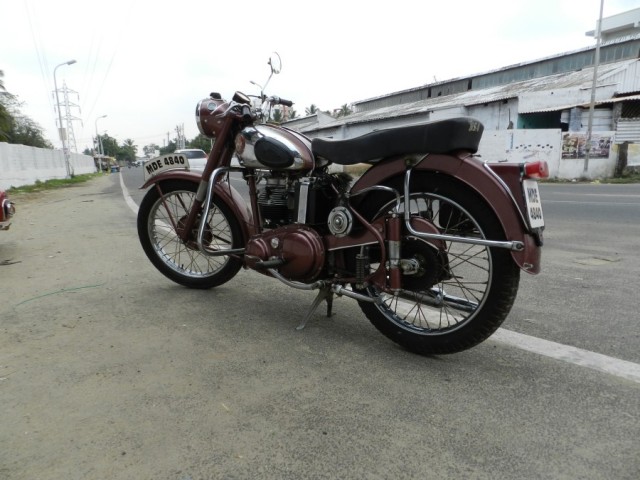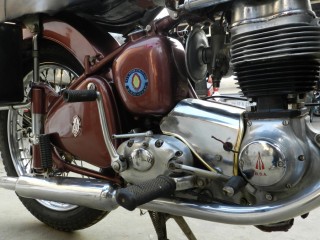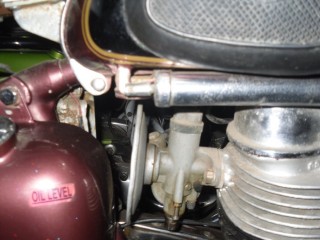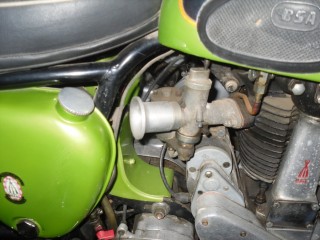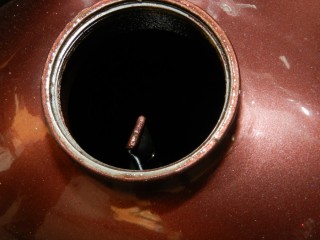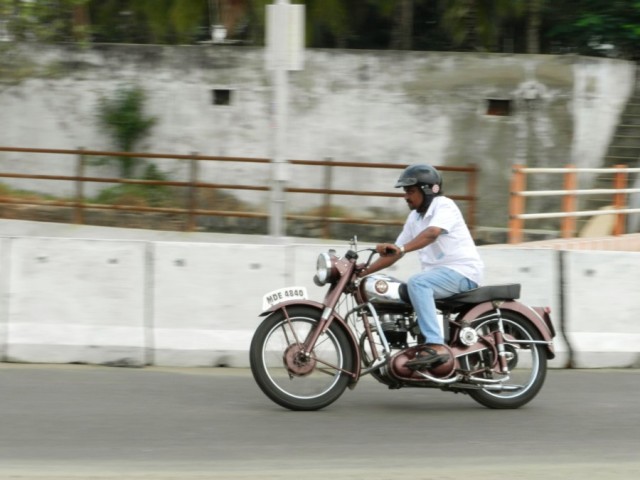
I really wanted to get this shot. Framed perfectly. I knew I would have to ask Muthukumar to take the turn again. Having already asked too much of the man when doing the Norton WD 16H photoshoot, I was slightly hesitant to ask him to do the run again. Ever the gracious host and easy going enthusiast that he is, the 1954 BSA C11G was graciously scorching, if you would forgive me for that phrase i just made up, the same patch of tarmac again, and again. I think it’s that custom paint job, ‘Rossa Mettana Effect’ he calls it. Everytime she passed me by I’d get caught up in her beauty and forget to do my job. So it was a while before I managed to get this shot.
The most popular of the BSA singles are the M20, used extensively in WW2, and the 2 stroke Bantam. These models had the magneto and dynamo setup. Relatively less known is the C range, that has always had coil ignition and until 1954 a dynamo was used to charge the battery. It was sometime in 1954 when the C10 and C11 were replaced by the C10L and C11G with alternators. The C11G also had the options of plunger or rigid frame and three or four speed gearbox.
The BSA C11G is powered by a 249cc four stroke motor with a compression ratio of 6.5:1 and is an OHV unit. The C10 and C10L had the side valve engine, which were in production till 1958. The C11G was replaced by the C12 in 1956, which had the same engine, but mounted in a pivoted fork frame.
You’ve had the pleasure of acquainting yourselves with the motorcycles Muthukumar has painstakingly restored, we thought it’s time you also got to know the man himself.
It was not Motorcycles initially. It was cars, engines and motorsports involving cars ( TSD Rallys, Dirt races and track events).I still remember ( would have been 6 or 7 year kid) Formula 1 Champion Mr.Jackie Stewart came for an inaugural function of MMSC ( Madras Motor Sports Club) some 40 years back. I used to dream about becoming a NIKI Lauda. In those days even a wealthy Indian like Dr.Mallya could only dream.
I was advised that “Bikes are not safe machines for commuting”, and much more dangerous is bike racing! As far as watching races at Sholavaram was concerned, I preferred bikes ( particularly Open class) than cars.
In those days I used to lament our motorcycle tuners for their poor performance but now i understand, with the limited available facilities at that period they have done wonders. Even before doing my engineering ( Mechanical and Production) , I could understand engines and production machines a bit more than the average student who comes from a non-tech background.
My first two wheeler was a Suvega during the years ’80 or ’81. It was a gift from my Dad’s friend. Though my heart yearned for bikes,so much more than cars, consistent preaching by all and sundry made me stick to cars.
I was promised a bike though and would be allowed to participate in a TSD Rally in only a car, if I passed out with distinction in B.E. It happened and in the year 1987 my Dad bought me a Yezdi CL11 and on exactly the 8th day I crashed into a Lorry and added extra chilly to their safety advice.
Notice the custom designed saddlebags and if you have the eye for it, the custom made badge on it. Muthukumar also has the skills to wield etching tools to get these badges done. The tyre inflator that was standard on most British bikes of that period.
Muthukumar about the Scissors Action Rally and his work for Enfield India:
I was back in action in 3 months, participating in the ‘Scissors Action Rally’ in a 1967 Premier Padmini FIAT (MDM 51), wearing competitor number 151. This being our (Santosh, myself and 2 other guys) first participation in a major event, we were placed 7th overall. I think that year there were nearly 60 entries including both two and four wheelers.Frad Bathena’s team won the Rally in 4 W category and Nanjappas in the 2 W ( TVS Supra SS). Mr.Karthikeyan appreciated our effort. It was a great accomplishment to even finish a rally like that. After that, I din’t have a chance to participate, as we didn’t have funds to go on in a professional way.
In those days, it was hard to find sponsors. Soon after that I moved to Madras, indulging in my toolroom activities, even at Madras I was not allowed to touch bikes, but it happened so. I was destined to work on tools for “Enfield India”, where some of the German Tools (DIEs) were modified or re-worked as per customer advice (based on Enfield India’s drawings). Though I was not riding bikes, I was atleast working on tools for motorcycle components.I remember working on the Fury’s timing case cover die, clutch side cover die, Explorer’s cover die etc. On several occasions I had chance of visiting all the units of Enfield, but I didn’t make any prolonged and informative visits. I do not know whether I was actually more interested in the cutting tools ( machines like the lathe, milling machines and the like) than the bikes OR if I was actually trying to heed my parents advice.
Where the C11 had the points housing angled into the timing case, in 1954 the C10L and C11G adopted alternators and points were housed in the timing cover. The other difference that distinguishes the C11G from the C11 is the increased fin area which also meant that the head studs extending downward had to be longer so the fixing nut lay below the fins.
This 1954 BSA C11G has an Amal Monoblock Carburetter. Shown below are pictures of the carbs on the C11G and another BSA. You will notice the standard trumpet air filter that rams air into the carb, whereas the C11G here has a trumpet filter with a much larger surface area, but shorter length. The space available for the air filter in the C11G is much lesser and hence such a filter.
The C11G, and all four stroke BSA singles have dry sump lubrication. The oil tank is on the right side of the bike and opening the oil tank cap and making sure that oil flowed through a hole inside was one of the pre-flight checks that had to be done before rolling the bike off the stand and moving on.
Muthukumar talks about his dreams and of his father, Mr.Kanakachalam:
After ’90 I migrated to Trichy , for some offshore engineering components manufacturing and then happened marriage . In ’92 returned to Coimby to set up my dream project, which didn’t happen till now and, I think it is too late now.
I wanted to indulge in a “Steel Casting Foundry ” ( not a cast iron foundry, which is common at Coimbatore). Project cost was beyond my capacity, so was dragging the idea along till ’95 , finally compromised and indulged in ‘Tool Room’ activities in a small way! Between ’92 and ’96, was helping out a lot in my father’s garage, and apart from the regular service work, he was always busy with vintage car restoration for serious enthusiasts!
At that time we used to have cars like the Standard 10, Land Master Woody and also big cars like Austin 12, Wolsely, Hillman, Prinz, Merc 210 SE etc, but not all at the same time period, but one after other.
My Dad ( late Mr.Kanakachalam ” aka ” Ganesh) had completely restored one motorbike in his life time…it was an Ariel Square FOUR, for Narain Karthikeyan’s Family. My dad’s Car tuning skills came to the limelight, when he joined CAI, Coimbatore Auto Industries. Though my father was not highly educated, he had this ability to learn in very short time periods, and had good common sense. Initially he tuned cars for the late Mr.G.Varadraj (Narain’s grandfather) for Sulur races during the early ’60s.
He had also made a custom car which he called ” MORFIA” with his colleagues, for Mr.G.Varadaraj , in Indian Open category who eventually went on to finish first in both the races ( a 6 lap event & a grand prix (50 laps). The Morfia had its chassis from a Morris and engine from a Fiat, a 1100cc modified with Isky cams.
It is only when you sit down to talk to a true blue enthusiast like Muthukumar that you realize the number of misconceptions with regard to restoration of British singles. When rigid frames were replaced with plunger frames, it was every biker’s desire to have a single piece seat for two up riding, as seen on this C11G instead of individual sprung seats. The single piece seats were in demand for the simple reason that it was a much more comfortable proposition for the pillion who was otherwise relegated to the mudguard, or any other form of a temporary seat bolted onto the mudguard. Not to forget the benefit for just the rider himself who has much more space to move around, especially on long rides. As Muthukumar pointed out, it isn’t uncommon for bikers even today to fit their motorcycles with individual sprung seats in complete disregard of the fact that the motorcycle rides on gas filled shock-absorbers mounted on a swinging arm.
You will remember the attention to detail by Muthukumar, for the seat upholstery work from the Norton WD 16H article. It wasn’t any different with the BSA C11G. It was worked on repeatedly for a number of days with Muthu wanting to achieve the perfect shape as seen in pictures of the motorcycle as it was when it rolled out of the factory. Initially the seat was out of shape, with some WFM Rajdoot’s foam. Removing all the deteriorated foam stuff Muthukumar and his trusted assistant Giri discovered ‘Made in England’ punched in the base plate. A decision was made, dents in the plate removed, fractured bits welded, then the base plate was sand blasted & powder coated. Of course, Muthukumar concedes, powder coating was not the order those days, but to preserve this beauty for years he had to adopt modern methods. Good sturdy , non textured mat black rexin was selected from Mumbai. Finally the BSA logo at the seat’s rear as shown in the image above, attached as a screen printing sticker.



